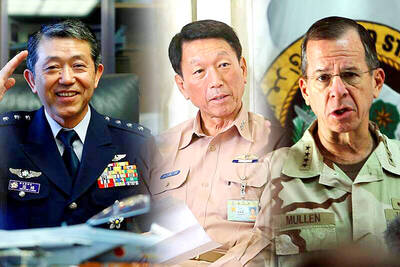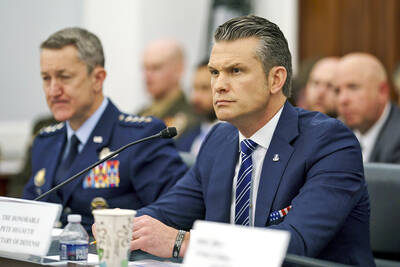Ukraine endorsed a US proposal for a 30-day ceasefire and agreed to immediate negotiations with Russia in crunch talks in Jeddah, Saudi Arabia, on Tuesday after three years of grinding war.
The positive response from Ukraine prompted US President Donald Trump’s administration to lift a freeze on military aid and to predict the beginning to an end of the conflict.
With Trump stunning allies by applying intense pressure on Kyiv and reaching out to Moscow, Ukrainian officials came to talks in Saudi Arabia eager to make up and had proposed a partial truce on air and sea attacks.

Photo: Ukrainian Presidential Press Service via AFP
Trump’s advisers pressed for more and said Ukraine agreed to their proposal for a full month-long ceasefire in a war that has claimed tens of thousands of lives.
“Today, we made an offer that the Ukrainians have accepted, which is to enter into a ceasefire and into immediate negotiations,” US Secretary of State Marco Rubio told reporters after about nine hours of talks in a hotel in Jeddah.
“We’ll take this offer now to the Russians and we hope they’ll say yes to peace. The ball is now in their court,” Rubio said.
“If they say no, then we’ll unfortunately know what the impediment is to peace here,” Rubio said of Russia, which launched a full-scale invasion of its smaller neighbor in February 2022.
Rubio said the US would immediately resume military assistance and intelligence sharing it had cut off to pressure its wartime partner following a disastrous Feb. 28 meeting between Trump and Ukrainian President Volodymyr Zelenskiy.
In Washington, Trump said he was ready to welcome Zelenskiy back to the White House and might speak to Russian President Vladimir Putin this week.
Asked by a reporter about the prospects of a comprehensive ceasefire in Ukraine, Trump answered: “Well, I hope it will be over the next few days, I’d like to see.”
“I know we have a big meeting with Russia tomorrow, and some great conversations hopefully will ensue,” he said.
In a joint statement, Ukraine and the US said they would conclude “as soon as possible” a deal securing US access to Ukraine’s mineral wealth, which Trump demanded as compensation for billions of dollars in US weapons under his predecessor, former US president Joe Biden.
Zelenskiy was supposed to sign the deal at the White House before the dramatic on-camera showdown, in which Trump and US Vice President J.D. Vance dressed down the wartime leader and accused him of ingratitude.
Zelenskiy quickly thanked Trump over the “positive” ceasefire proposal made in Jeddah and said the US must now work to persuade Russia.
“The American side understands our arguments, perceives our proposals, and I want to thank President Trump for the constructive conversation between our teams,” Zelenskiy said in his evening address.
Since the US cut off aid and intelligence sharing, Russia has stepped up attacks on Ukraine’s energy infrastructure and seized back land in Russia’s Kursk region, which Ukrainian forces had infiltrated.
Hours before the Jeddah talks, Ukraine staged a major direct attack on Moscow, with hundreds of drones slamming into the capital and other areas, leaving three people dead.

A Chinese aircraft carrier group entered Japan’s economic waters over the weekend, before exiting to conduct drills involving fighter jets, the Japanese Ministry of Defense said yesterday. The Liaoning aircraft carrier, two missile destroyers and one fast combat supply ship sailed about 300km southwest of Japan’s easternmost island of Minamitori on Saturday, a ministry statement said. It was the first time a Chinese aircraft carrier had entered that part of Japan’s exclusive economic zone (EEZ), a ministry spokesman said. “We think the Chinese military is trying to improve its operational capability and ability to conduct operations in distant areas,” the spokesman said. China’s growing

Nine retired generals from Taiwan, Japan and the US have been invited to participate in a tabletop exercise hosted by the Taipei School of Economics and Political Science Foundation tomorrow and Wednesday that simulates a potential Chinese invasion of Taiwan in 2030, the foundation said yesterday. The five retired Taiwanese generals would include retired admiral Lee Hsi-min (李喜明), joined by retired US Navy admiral Michael Mullen and former chief of staff of the Japan Self-Defense Forces general Shigeru Iwasaki, it said. The simulation aims to offer strategic insights into regional security and peace in the Taiwan Strait, it added. Foundation chair Huang Huang-hsiung

PUBLIC WARNING: The two students had been tricked into going to Hong Kong for a ‘high-paying’ job, which sent them to a scam center in Cambodia Police warned the public not to trust job advertisements touting high pay abroad following the return of two college students over the weekend who had been trafficked and forced to work at a cyberscam center in Cambodia. The two victims, surnamed Lee (李), 18, and Lin (林), 19, were interviewed by police after landing in Taiwan on Saturday. Taichung’s Chingshui Police Precinct said in a statement yesterday that the two students are good friends, and Lin had suspended her studies after seeing the ad promising good pay to work in Hong Kong. Lee’s grandfather on Thursday reported to police that Lee had sent

BUILDUP: US General Dan Caine said Chinese military maneuvers are not routine exercises, but instead are ‘rehearsals for a forced unification’ with Taiwan China poses an increasingly aggressive threat to the US and deterring Beijing is the Pentagon’s top regional priority amid its rapid military buildup and invasion drills near Taiwan, US Secretary of Defense Pete Hegseth said on Tuesday. “Our pacing threat is communist China,” Hegseth told the US House of Representatives Appropriations Subcommittee on Defense during an oversight hearing with US General Dan Caine, chairman of the Joint Chiefs of Staff. “Beijing is preparing for war in the Indo-Pacific as part of its broader strategy to dominate that region and then the world,” Hegseth said, adding that if it succeeds, it could derail